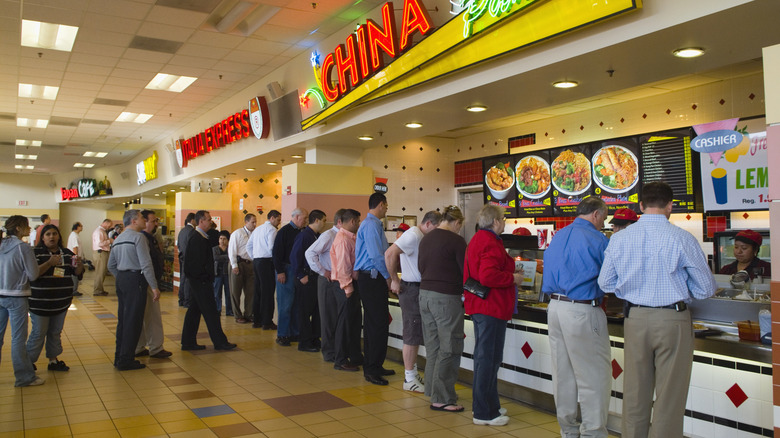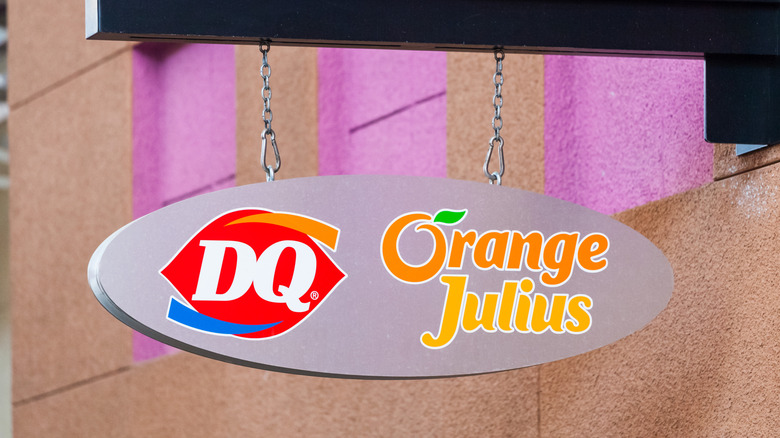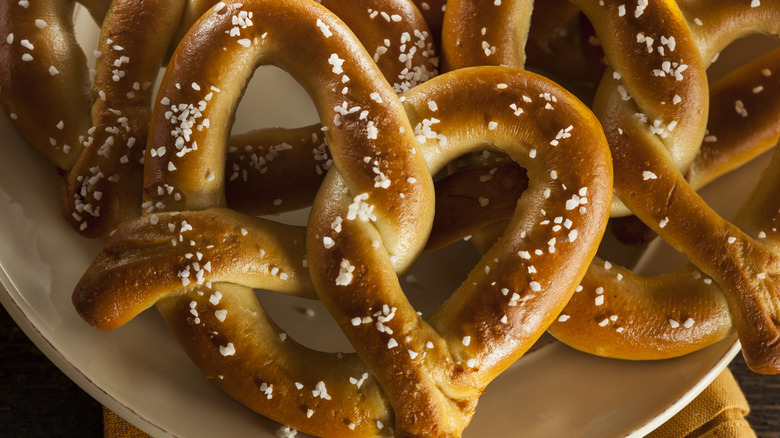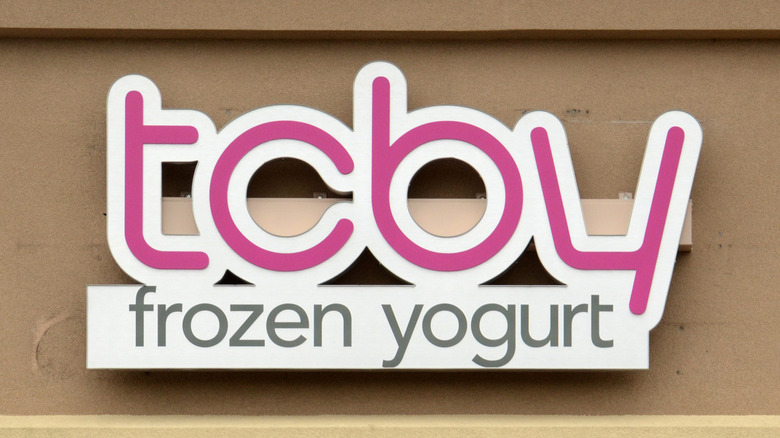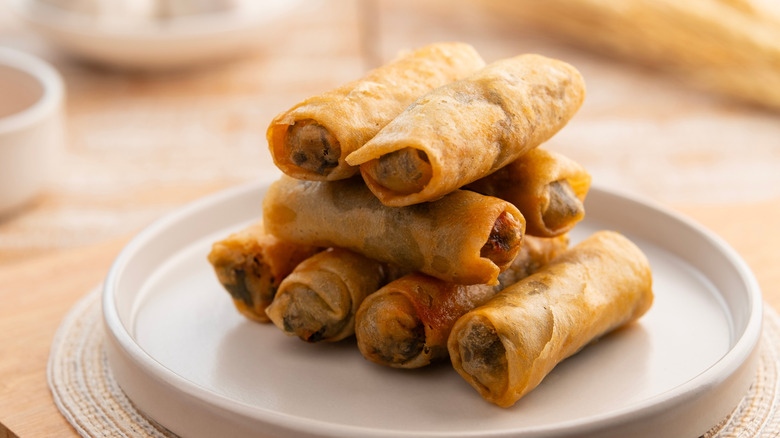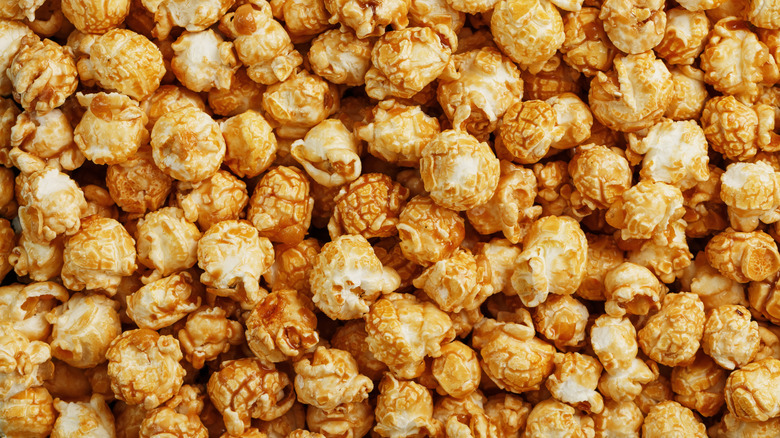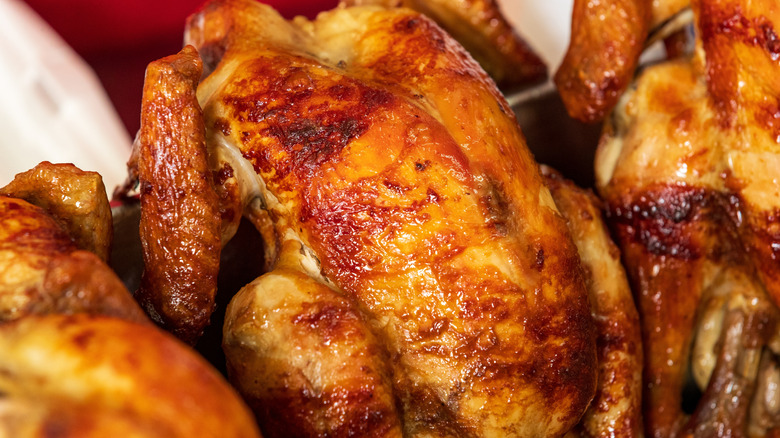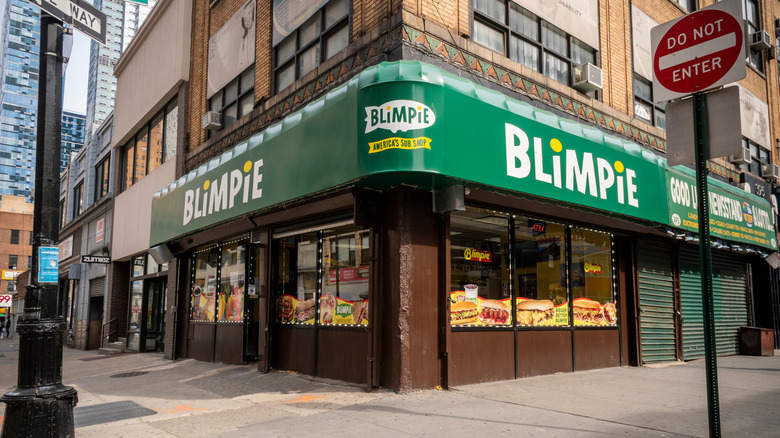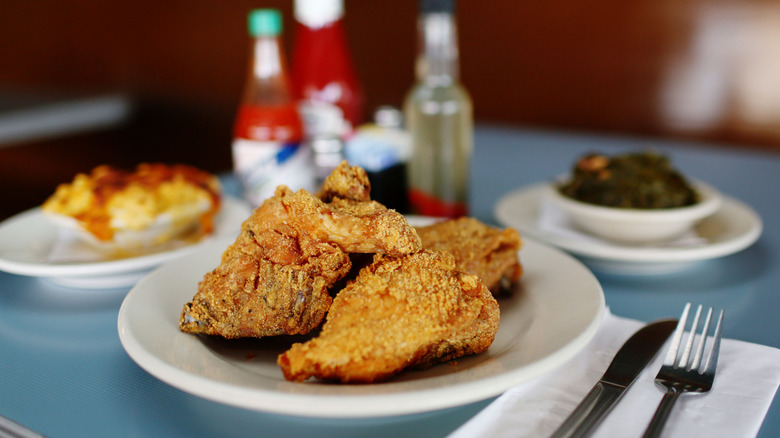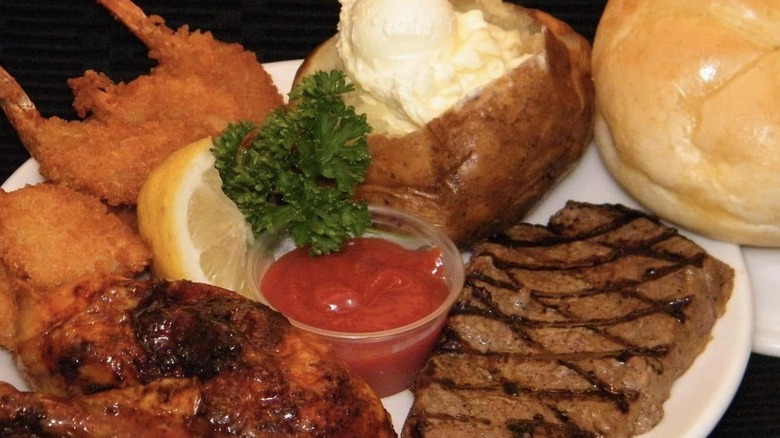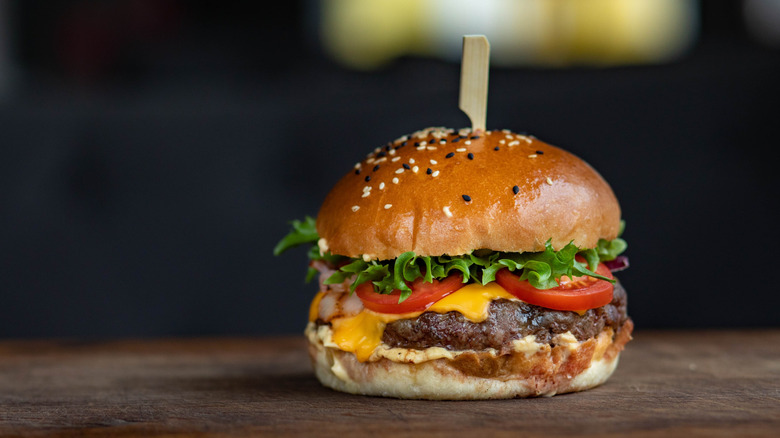10 Vanished Mall Food Court Restaurants You Forgot About
Ah, the mall. Since the opening of the first indoor shopping center in Edina, Minnesota, in 1956 through their heyday in the 1970s and 1980s to today, malls have been a core part of American culture. Beyond being a convenient place to shop and find many of your favorite stores and chains, malls have long served as community hubs and gathering spaces. Tweens and teens meet with friends to hang out, and families share quality time while running errands.
Along with shopping and family fun, dining at the food court is a core part of the whole "going to the mall" experience. In echoey atriums full of dining tables, mall-goers find all sorts of fast, casual fare to fuel their shopping adventures, from hot slices of pizza from Sbarro to crinkly Styrofoam containers heaped with Chinese food. You can grab a table and sit down for a meal, or pick up a quick treat like swirly soft-serve ice cream to enjoy on the go while strolling from store to store.
But as consumer habits have increasingly shifted to online shopping, the American mall has been in decline, with many stores and chains shuttering. Sadly, that includes several familiar food court favorites. You may even have forgotten that some existed until now. Let's take a stroll down memory lane to revisit 10 restaurants and eateries that have gone out of business or, in the case of some chains, still exist at a few locations but aren't nearly as ubiquitous as they once were.
1. Orange Julius
Shopping is thirsty work, and for many mall-goers, one restaurant always hits the spot for a thirst-quenching refreshment: Orange Julius. A popular beverage chain, Orange Julius was, and is, best known for its namesake drink, which is a frothy, fruity mix of orange juice, sweetener, milk, powdered egg whites, vanilla flavoring, and ice.
Even though Orange Julius is solidly associated with mall food courts, the brand predates modern malls by several decades. Founded by Julius Freed in 1926, it started as an orange juice stand in Los Angeles, California. But it was Freed's real estate broker, Bill Hamlin, who first created the Orange Julius to make a less-acidic beverage that was easier on sensitive stomachs. The result was a big hit with Freed's customers, who started saying "Give me an orange, Julius!" as they lined up. By the 1960s, Orange Julius had around 400 locations across America, and the drink had even been named the official beverage of the 1964 World's Fair.
After becoming a subsidiary of soft serve ice cream giant International Dairy Queen in 1987, Orange Julius started being assimilated by its new parent company, with locations changing into Dairy Queens. The drink itself remained easy to find, as Dairy Queen kept it as a menu staple at its "Treat Center" locations. However, by 2018, all stand-alone Orange Julius locations had been officially turned into Dairy Queens. But this iconic mall beverage lives on at select Dairy Queen locations and still has a dedicated fan club.
2. Hot Sam Pretzels
Hot, chewy, and easily portable, soft pretzels are the perfect mall food, hence the popularity of chains like Auntie Anne's, with its sugary glaze sauce, and Wetzel's Pretzels. But the chain that paved the way was Hot Sam.
Founded in 1966, the first Hot Sam Pretzels opened in Detroit's Livonia Mall. Baking its Bavarian-style soft pretzels in rotating ovens, the wafting scent of warm dough tempted customers over to the brand's cozy, red-brick storefronts. The convenience and comforting aromas and flavors clearly struck a note with mall-goers; by 1985, Hot Sam had expanded to more than 175 locations in malls across America. Drawing in between $30 to $50 million annually, its success caught the attention of mall cookie giant Mrs. Fields, which bought the brand in 1995. The following year, Mrs. Fields acquired the Pretzel Time brand (now Pretzelmaker). Focusing most of its resources on Pretzel Time, Mrs. Fields deprioritized Hot Sam and either closed locations or converted them into Pretzel Times. The last few Hot Sam locations finally made the shift to Pretzel Times in 2005.
Even though the physical stores no longer exist, the memory of Hot Sam lives on in a blast-from-the-past on-screen cameo in Netflix's mega-hit series "Stranger Things." Trying to recreate the atmosphere of a real 1980s mall in the fictional Starcourt Mall for Season 3, the show featured a Hot Sam location in the mall food court near the Scoops Ahoy ice cream store where star characters Robin and Steve work.
3. TCBY
Nowadays, if you hear the term "frozen yogurt," your mind probably goes straight to popular stores like Pinkberry and Menchie's. But before these chains became household names, there was a different brand that first put frozen yogurt on the map: TCBY.
Standing for "The Country's Best Yogurt," TCBY rose to prominence during the diet craze of the 1980s. People loved the taste of ice cream but wanted a healthier option with less fat and sugar. Opened in 1981, TCBY filled the gap with frozen yogurt, which had just been invented the decade before. Fro-yo quickly caught on, and TCBY grew to over 100 stores by 1984. Throughout the 1990s, TCBY continued to expand, reaching nearly 1,800 locations by the early 2000s. In 2000, Mrs. Fields Cookies scooped up the chain, adding to its sweet treats empire. But as newer, trendier fro-yo chains like Pinkberry came on the scene, TCBY struggled against the competition.
As more brands have tried to stake a claim in the multi-hundred-million dollar frozen yogurt industry, TCBY has definitely fallen from its peak over the past few decades. Decreased foot traffic to malls also played a role in the downsizing. But it has still managed to hang on throughout the 2010s fro-yo boom with around 350 locations nationwide. So if you're after a bite of the frozen yogurt brand that helped make this frosty treat into the mega-hit it is today, you can likely still find a location in your general area.
4. China Coast
One of the hallmarks of the American mall food court is the fast-casual American Chinese restaurant, slinging savory chow mein, crunchy egg rolls, and sauce-laden General Tso's Chicken to hungry shoppers. For a brief period in the early to mid-1990s, China Coast aimed to be that go-to spot.
When the first outpost opened in Orlando, Florida, in 1990, China Coast seemed set for success. Its parent company was General Mills Restaurants Inc., whose portfolio included classic chains like Olive Garden and (at the time) Red Lobster. Hoping to appeal to American diners, the menu leaned heavily into Americanized Chinese fare like "China Coast Bread," a steamed roll covered in an amaretto almond spread, alongside more familiar dishes like General Tso's Chicken, hot and sour soup, and a Jing Jang platter of egg rolls, crispy noodles, vegetable sticks, and dipping sauces. Other non-Chinese dishes featured Chinese-inspired names, like a dessert called the Great Wall of Chocolate.
After finding some success in the Orlando area, the chain went for a nationwide expansion in 1993. At its peak, China Coast had 51 locations. But branching out also led to its downfall; the brand struggled financially and faced stiff competition from locally-owned Chinese restaurants in other markets. Citing an inability to compete against the quality of food and service at rival eateries, China Coast's parent company closed all locations in 1995, just five years after the brand's initial launch.
5. Karmelkorn
While many restaurants are closely associated with mall food courts, some of those same chains got their start before malls were even a thing. One such example is Karmelkorn, a popcorn purveyor that made its name popping fresh gourmet popcorn with flavors like caramel, butter, and yellow cheddar.
In 1929, nearly three decades before the first indoor shopping mall opened in the 1950s, Karmelkorn was founded. Starting from its home base in Casper, Wyoming, the brand began by selling its sticky caramel corn and other delectable popcorn flavors from licensed vendors and storefronts in downtown areas. But as malls came on the scene in the mid-1900s, Karmelkorn started operating stand-alone stores in strip malls and indoor shopping centers. By the 1980s, there were 270 locations across 43 states, giving shoppers the perfect sugary or buttery snack to accompany their errands. Then, in the late 1980s, Dairy Queen acquired Karmelkorn to start selling the products alongside its own frozen treats and Orange Julius drinks in its "Triple Treat" Dairy Queen Treat Centers.
It was the decline of American malls, and lack of support from its parent company, that led to the closure of most Karmelkorn stores. But they're not gone completely. Devotees can still purchase bags of gooey caramel corn and other flavors from Karmelkorn's online shop or find them locally around Nebraska.
6. Kenny Rogers Roasters
Roasted to juicy, crispy perfection, rotisserie chicken is always a hit come meal-time; just ask Costco with its uber-famous $5 rotisserie chickens. But many people may not think of it as the best choice for an easy bite at the mall. However, in 1991, one brand changed that.
Founded by country music star Kenny Rogers and John Y. Brown Jr., an early investor and former CEO of Kentucky Fried Chicken, Kenny Rogers Roasters brought wood-fired rotisserie goodness to mall food courts after opening its first location in Coral Springs, Florida. Despite facing competition from rival brands like KFC and Boston Chicken, and even a lawsuit from Clucker's, the brand grew to around 350 outposts. In addition to its chicken, diners loved the fluffy corn muffins and other Southern comfort-food sides. It was so popular, it was even featured in an episode of "Seinfeld." Despite its pop culture success, it filed for Chapter 11 bankruptcy in 1998 and was acquired by hot dog heavy-hitter Nathan's Famous Inc.
If you have a hankering for the chain's signature rotisserie chicken or corn muffins, you'll be happy to hear that it's still around. But you'll need to hop on a plane to satisfy your craving. Thanks to the brand being acquired by a Malaysia-based corporation in 2008, the chain's remaining locations are scattered throughout Asia in places like Singapore, United Arab Emirates, Indonesia, and the Philippines. It's clearly thriving too, with hundreds of locations around the region.
7. Blimpie
Founded in 1964 by three high school friends from New Jersey, Blimpie was one of the forerunners of the chain subway sandwich shop model. Fresh, made to order, and with endlessly customizable options, subs are a natural fit for the mall crowd. And, as sub shops allow you to personalize your sandwich with healthier options like vegetables, whole grain bread, or leaner meats, it's often perceived as a more health-conscious choice than other fast-food chains.
Drawing inspiration from a different local subway shop that would eventually become Jersey Mike's, Blimpie quickly found a market and expanded to around 1,800 locations. But even though rival chain Subway debuted just a year later, Subway has continued to thrive and expand into the giant it is today, with locations in all 50 states. Meanwhile, Blimpie has faded in popularity and gone down to around 200 stores. Why is that? A bad mix of ownership changes, difficulty with franchise expansions, and issues balancing finances all led to a gradual decrease in locations. In 2012, Kahala Brands took over the chain and now manages it along with its other brands like Cold Stone Creamery.
Even after its heyday, it still retains cultural relevance, as the chain was referenced in a 2013 episode of the sitcom "30 Rock." So you can still pop into a Blimpie's for one of its signature subs, but you're more likely to find them in gas stations or stand-alone locations than in a mall food court these days.
8. Morrison's Cafeteria
From stand-alone diners to mall food courts to hospitals, the Morrison's Cafeteria brand has had a wild ride since its opening in 1920. Founded in Mobile, Alabama, and mostly located throughout Florida, Georgia, and the southeastern United States, Morrison's made a name for itself with its Southern comfort food fare. Lining up at long buffet tables in its casual dining rooms, diners could find a wealth of classic all-American and Southern dishes like fried chicken, meatloaf, and apple pie.
As the brand branched out across the United States, the rise of shopping malls found many Morrison's locations setting up shop within food courts. The variety of food options and convenient, accessible setting made it ideal for families. This being the southern United States in the early-to-mid-1900s, though, Morrison's was founded as a racially-segregated business and strongly resisted efforts to desegregate until the passing of the Civil Rights Act in 1964. As the chain grew, reaching upward of 150 locations at its peak, it also acquired another small restaurant business in 1982: Ruby Tuesday.
Ruby Tuesday would go on to mostly outlive Morrison's. Due to changing consumer tastes and loss of interest in cafeteria-style dining, Morrison's split into separate divisions in the mid-1990s, which included a food service branch for hospitals and healthcare providers. In 1998, the brand was finally bought out by rival chain Piccadilly Cafeterias. Piccadilly still operates one Morrison's in its home state of Alabama, and many hospitals and senior living facilities nationwide get their food services through Morrison Management Specialists.
9. York Steak House
Another notable stand-out from the era of mall cafeteria dining, York Steak House made a name for itself with its selection of American steakhouse classics made easy for fast-casual dining. Served cafeteria-style, diners could enjoy hearty meat cuts like sirloin, pork chops, and ribeye to go with plentiful hot and cold side dishes.
Founded in 1966 in Columbus, Ohio, the chain's origins are deeply tied to malls. The first location was across the street from the old Westland Mall, and the second location popped up inside South Portland's Maine Mall in 1971. Acquired by General Mills, Inc. in 1976, York Steak House continued to expand to malls across America, reaching almost 200 locations across 27 states by 1982.
Over the following decade, though, General Mills started closing more and more locations as the tastes, appetites, and preferences of mall-goers changed. But a few locations remained open as independent operators, most notably one in Columbus near the former location of the very first outpost. This final York Steak House is still open and beloved by locals who, when the restaurant went up for sale in May 2024, clamored for potential new owners to keep it just as it was.
10. Mr. Fables
If you're from western Michigan, odds are that trips to the mall included stops at the local Mr. Fables for burgers and onion rings. Found in malls throughout the region, this fast-food burger chain was best known for its unique burgers, like the Olive Burger, and its secret recipes for onion ring batter and burger sauce.
Originally, the food shop opened in 1929 as a licensed location for Kewpee, one of the earliest fast-food hamburger chains. Over the years, owner and operator Gerald Boyles ended up tweaking the chain's recipes and adding his own twists. Seeing the potential in his father's innovations, his son John Boyles bought out the location with his cousin Dick Faber in 1963 and renamed it Mr. Fables — a portmanteau of the new owner's two last names.
With locations in popular malls like Grand Rapids' Woodland Mall and Holland's Westshore Mall, the burger brand expanded to 17 locations around the West Michigan area. After selling to Colonel Chicken, Inc. in 1988 in the hopes of becoming a national chain, the business faltered and started to decline, with the final location closing up shop in 2000. But its signature secret recipes remain fondly remembered by locals, who are still trying to crack the code for what exactly made the onion batter and burger sauce so satisfying.
